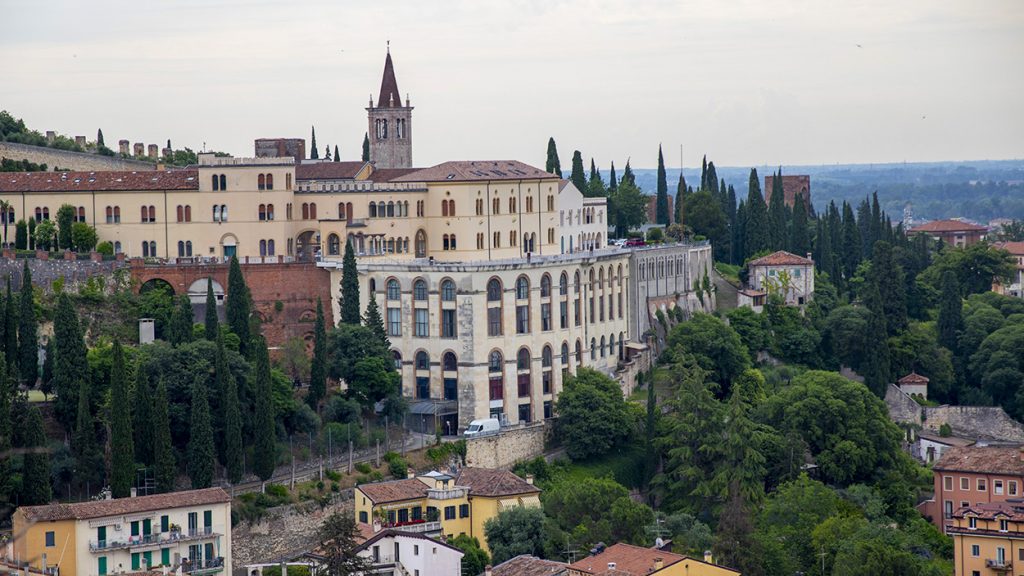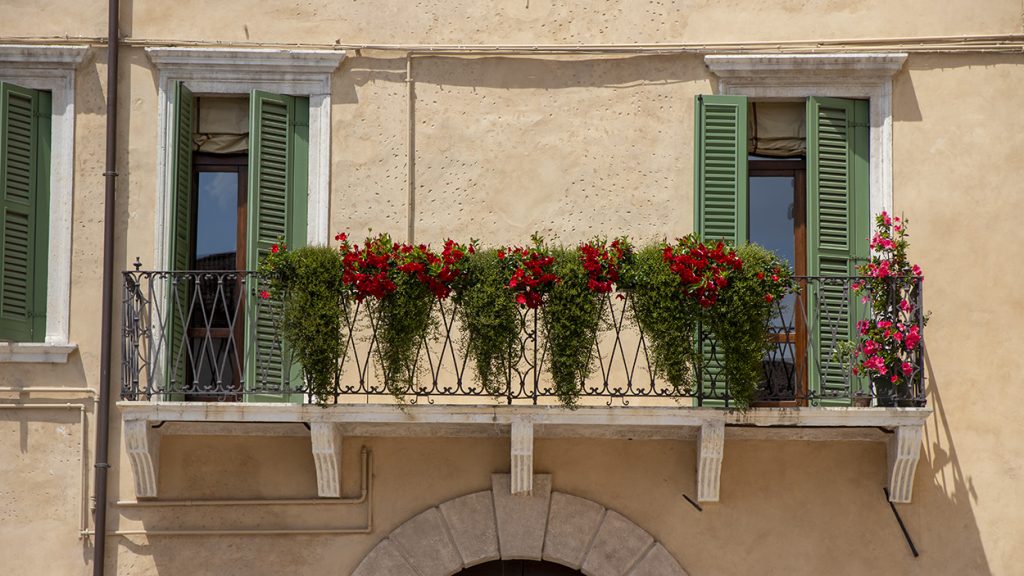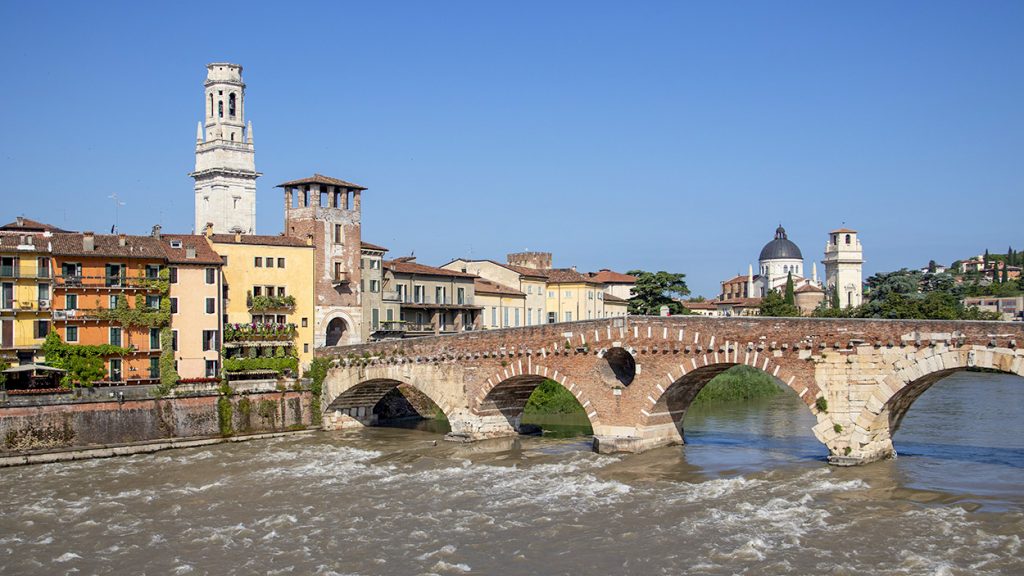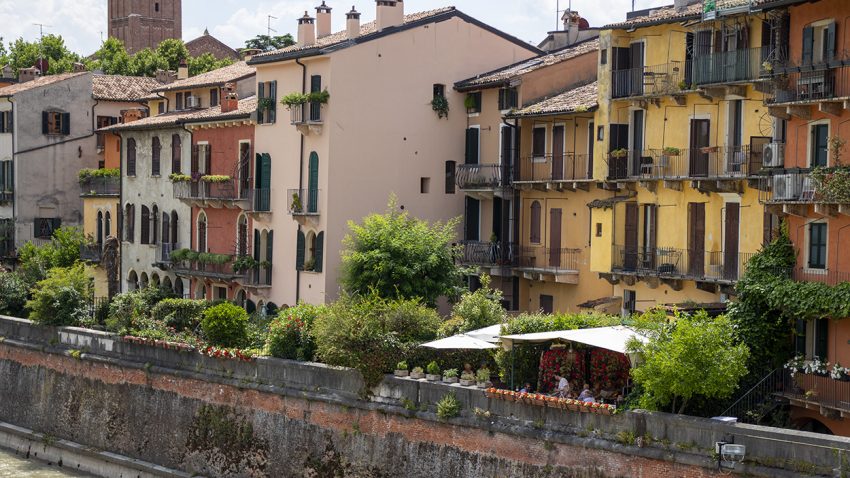From Venice, travel deeper into the landscape of the watery Veneto region and you enter an Italy suspended in amber, where the disparate architectural elements of ancient Rome, the Middle Ages, and the Renaissance come together beautifully. The charming city of Verona becomes a picture-perfect postcard scene created over the centuries, unbroken for generations. The imposing Roman walls encircling the ancient city acted as a formidable barrier, hindering the 19th-century advancements in industry and the expansion of railroads within its storied confines.

However, modernity – as is the case almost everywhere that tourists tread – has of course found its way into the heart of this ancient town, and for the most part, thankfully so. As enchanting as it is to rest a night or two within the warm embrace of a five-hundred-year-old former renaissance villa, with weathered walls painted in limewash the colour of a Tuscan sunset, it is also rather lovely to rest one’s weary head upon a fluffy, hypoallergenic pillow.


Travelling from Venice to Verona by train today is, fortunately, a rather simple affair. Trains leave frequently from Venice’s main station, Venezia S. Lucia, and in a mere hour and twelve minutes – according to my paperless ticket – you will find yourself alighting most unwrinkled and rather fresh faced at the platform of Verona Porta Nuova. This austere, storm-cloud-grey train and bus station owes its rather sombre façade to the prevalence of futuristic military architecture that was popular in Italy after the destruction caused during the Second World War. As in most cities or larger towns the railway station is often the least interesting aspect of any visit, and it is with an adventurous spirit – and the lure of an Aperol Spritz on a balmy June afternoon – that we forgo any lingering, and soldier on towards the direction of the old town.
Despite many years of travel in Italy, mum and I are often determined to walk whenever possible – even if that means lugging a month’s worth of luggage over paved streets for twenty minutes in the unrelenting sun. We did the same in Venice only a week before and swore we had finally learnt our lesson. Apparently not!


Modern sidewalks soon give way to quaint cobbled streets and in the distance I can see a faint haze of medieval architecture and chiselled stone, and all thoughts of contemporary life soon fade away. A sweep of golden light permeates the old town presenting a piquant contrast to the modernity we so recently left behind. Buoyed by the magnificent surroundings my suitcase feels somehow lighter and the making of a blister on my right heel seems to have suddenly disappeared. For six days this magical place will be our home away from home, and though time is in abundance here, we drop our bags inside our lovely little B&B with barely enough time to soak in the relaxing atmosphere. Nestled in the foothills of Verona, close to the funicular station that ferries visitors up to St. Peter’s hill, and a mere five minute walk from Ponte Pietra – the town’s breathtaking old stone bridge – our temporary abode is perfectly placed for a little afternoon wandering among the beauty that is Verona.


Mum has visited Verona previously and is eager to show me the many historical treasures that resonated during her memorable stay, only a few years before. In defiance to the mid-afternoon heat, we venture forth in search of the ancient stone steps which meander upwards to Castel San Pietro and the Punto Panoramico, one of the best vantage points in Verona.



We ribbon our way slowly upwards, past a faded watermelon-pink villa whose vibrant mustard seed-yellow shutters are the only indication that someone still lives within. Pausing for a moment to catch our breath, we seize the moment to admire the mounting view. The wall that follows the pathway upwards is clothed in greenery, creating privacy for the smattering of residences that reside adjacent to this public way. The ledges which border these properties are artfully arranged with all manner of tactile and aromatic plants that abundantly disgorge from decorative terracotta pots.


The verdure of the early summer trees lines the path that leads our way, and every few minutes, between the foliage, we pause to catch glimpses of the animated Adige River below and the ancient town that spreads out so picturesquely in the distance. Reaching the summit finally reveals a view so perfectly framed between the branches of pine trees. One could stand before that magical panorama for hours and never grow old!





This little expedition now becomes a wonderful introduction to the layout of the city and from here we soon get our bearings. We observe a vast landscape of gentle hills and warm stone architecture which yield to pockets of dense, rolling absinth green forest whose broad shoulders appear to be drenched in a swathe of chlorophyll. In one direction, perched atop Belvedere Hill rests the Sanctuary of Our Lady of Lourdes, a peaceful resting place serving as both a pilgrimage site for the devout, and a haven of tranquillity for those seeking solace amidst its peaceful environs. As is common to all Italian towns and cities we notice a profusion of bell towers and church spires dotted throughout the city below. Verona has already captured my imagination from this viewpoint, and I am eager to explore. We spy a café near the castle and after our first of many spritzes in Verona, we reluctantly descend the lovely punto panoramico, this time taking advantage of the strategically placed funicular.

We forge on towards the Basilica di Santa Anastasia, whose red-bricked steeple we had admired from up high. In order to reach our destination, we must first traverse the Ponte Pietra bridge, an elegant marvel crafted over two millennia ago by the Romans. A wonder to behold from afar it evokes a sensation akin to strolling amidst the ancient vestiges of Rome itself. History feels both unfathomable and yet immediate, as if the passage of time seems trivial somehow. Ravaged nearly to ruins by withdrawing German forces at the end of the Second World War, this ancient edifice, with its partial restoration during the Middle Ages, was meticulously reconstructed in the late 1950s, preserving its essence through the utilization of its original natural materials.



Stepping foot into Basilica di Santa Anastasia feels like a plunge into a breathtaking symphony of colours and history. The year 1290 lingers in the air, alive with the clinking of coins as Verona’s influential families fuel the birth of this grand architectural marvel. As I step inside, I am instantly struck by its magnificent and elaborate design. Pillars divide the space into three sections, each adorned with a luminous display of 14th century architecture. But what truly captivates me are the exuberant Gothic and Renaissance marvels that adorn every inch of the space. It is more than a place of worship; it is an art gallery brought to life, with altars, frescoes, and relief decorations intricately crafted to tell captivating tales of history and creativity.




The columns stand proud, adorned in a mesmerising blend of red Veronese marble, the pristine white from Istria, and the mysterious allure of black basanite underfoot. Each step resonates with centuries of craftsmanship and opulence.


Venturing deeper within, the basilica reveals its hidden trove of artistic wonders. Pisanello’s St George and the Princess adorns the Pellegrini Chapel, a fresco that seems to breathe life into the stone walls, narrating tales of chivalry and romance with each lyrical brushstroke. Every complementary colour seems to harmoniously coexist as though rich and pure pigments were poured directly from their metallic tubes. Veridian green, ochre, brick red, deep royal blue, dusky pink, and washes of gold enliven the already heaving interior.


At the entrance, the holy water stoups stand as silent witnesses, carried by figures of hunchbacks. These stooped figures, symbolic of the toil woven into the basilica’s very foundation, hold a whispered promise of good fortune. Legend reveals that one touch to their humps bestows luck—a tangible connection to the enduring spirit that birthed the Basilica of Saint Anastasia.


The basilica is not just a structure; it is and was a living testament to Verona’s essence, pulsating with the passions, ambitions, and artistic brilliance that defined the city across epochs. The space has a cloistered intimacy that entices me to explore beyond its walls, inviting me into a realm where history, art, and superstition intertwine, creating an enchanting tapestry that seems determined to transcend time.


I have visited many churches and grand cathedrals in Italy over the years, and each in its way seems more beautiful than the last – as in England each and every newly traversed National Trust property seems to outshine the one before. Yet there is something truly wondrous about Verona’s majestic basilica; to this day it appears determined to outshine all others. The colours are at once both rich and pleasingly muted, and the naturalistic motifs painted using sage green and brick red upon the ceiling evoke decorative styles of the 20th century Arts and Craft Movement that held nature’s cherished bounty at its artistic core.


Leaving the cool embrace of the basilica we venture outside, blinking our way back into the warmth and brightness of the piazza. Somewhere in the vicinity I can hear glasses clinking and smell something rich and hearty bubbling away on the stove. A delicious aroma has asserted itself upon my senses. It might be too early for dinner, but a cold glass of spritz and a heavenly plate of something salty surely awaits. Aperitivo time!


I hope you enjoyed a special summer’s jaunt to the picturesque town of Verona, and its wondrous Basilica with The Sunday Londoner. Please do leave a comment below, I’d love to hear from you! Have you ever visited this lovely Italian town?



I just love Verona so much and your wonderful photos and poetic descriptions have reminded me of our wonderful visit there.
Stunning photos! I want to visit the basilica!